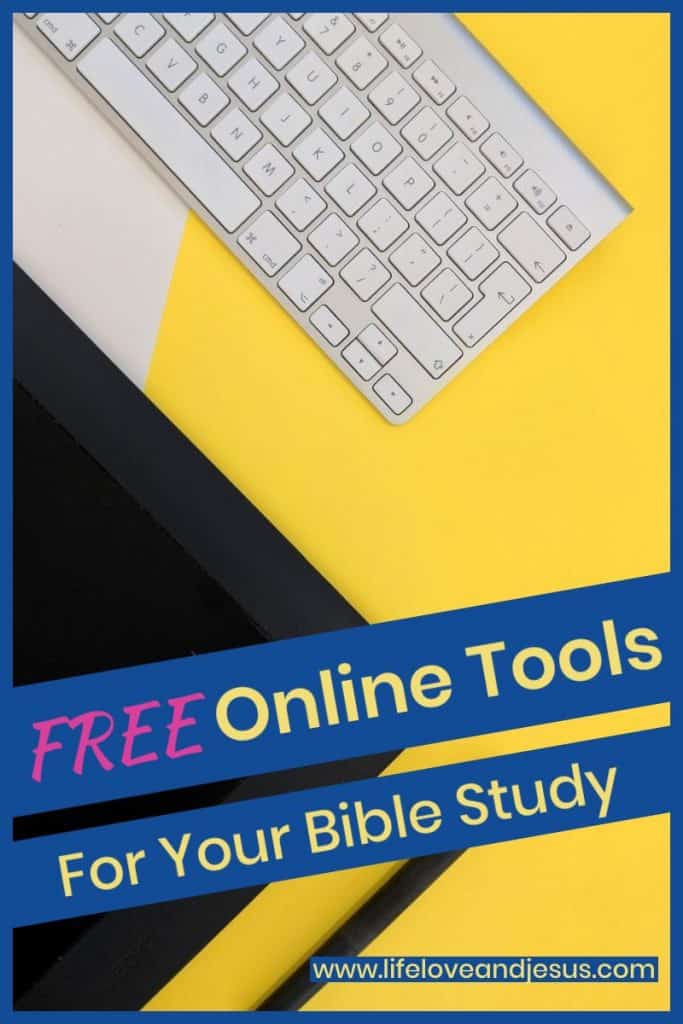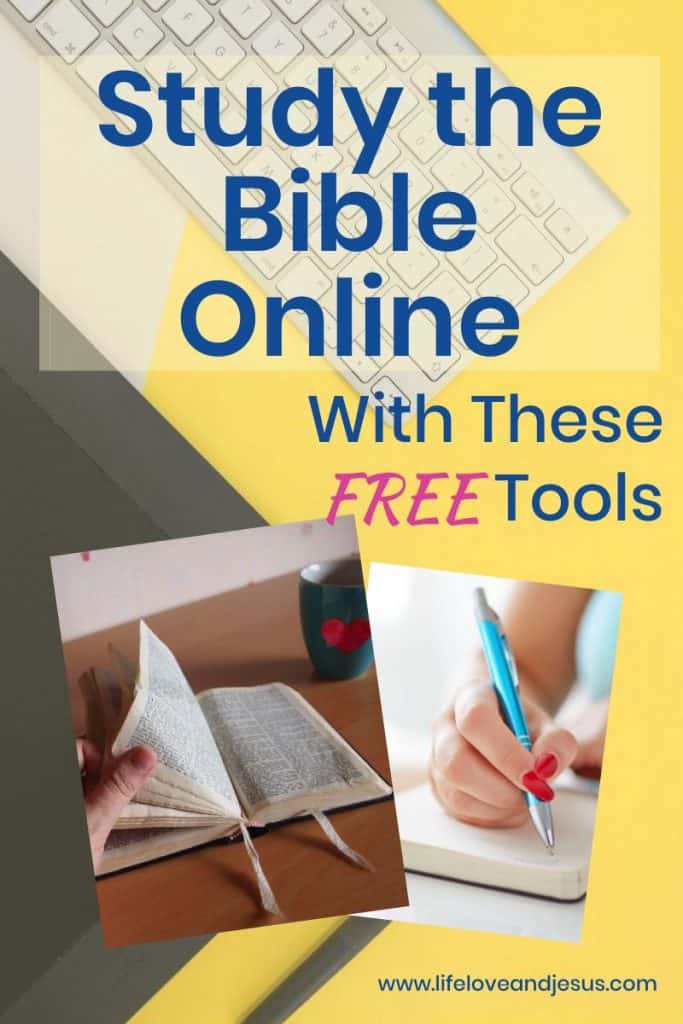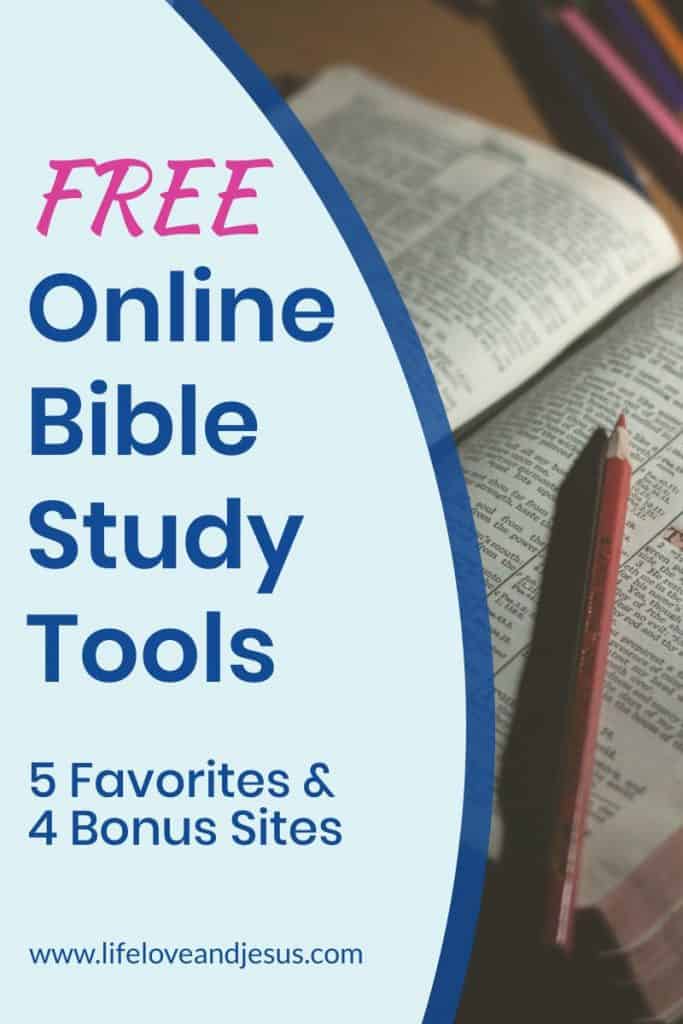Amazing and Free Online Bible Study Tools
This post contains affiliate links. If you click & make a purchase, I receive a commission! Thanks! Read my full disclosure policy. As an Amazon Associate, I earn from qualifying purchases.
Bible study takes effort. It takes time. It takes the willingness to dig into difficult passages or verses or stories. And it takes the right tools. Fortunately, you (and I) have access to dozens of amazing and free online Bible study tools.
If you search for “online Bible study tools” you will get 72 million results on Google. Since you don’t have the time to figure out which ones are worth your time, I’m sharing some of my favorites. (Honestly, I haven’t checked out all 72 million either!)

I have been using online Bible study tools for quite a while – along with my hard-copy favorites. Below are my favorites and a few that I use less frequently but are still chockful of Bible goodness!
5 Basic Bible Study Websites
These 5 Bible websites – which all have a variety of study tools – are my long-term favorites. They’ve all been available for several years. If you are just starting out with online Bible study tools, try each of them for at least a week to get a feel for the site.
After you’ve tried them all, you may find a favorite you return to over and over again. You may prefer the layout or colors of one site over another. Or you may like the tools that are available on this site but not that one. Poke around. Check out all they have to offer. Then settle on one as your ‘go-to’ while bookmarking the others for occasional use. (Sites are listed alphabetically – not by preference)

Each website is described briefly below, along with what I like or dislike about each site. These descriptions apply only to the free versions, although some of these websites also have a paid version, which I will indicate.
The paid versions give you access to many more tools. However, unless you’re preparing a sermon, going to seminary, or writing a Bible study, you’ll probably be just fine with the free versions.
To do a good “test run” of each site, you could pick a topic such as patience or gossip, and do a quick word search. Follow the links that come up to see what the various tools do. If you use the same term and the same Bible version on each website, you’ll quickly be able to decide which site works best for you.
Be prepared to take a few hours to do a proper “test drive” – but spread it out over several days if you need to.
Bible Gateway
Bible Gateway hosts more than 200 versions in 70+ languages. That number includes well over 50 English versions of the Bible. With those numbers, Bible Gateway wins the award for most versions.
What’s Good:
- I use the parallel Bible feature frequently – which is a common feature.
- I also like that when I search for a word, it brings up all words that start with it. For example, if I search for “mark,” it will also bring up “marked” and “markedly”. This is handy but also can backfire (see What’s Not So Good).
- A feature I love is the “[verse] in all English translations.” When you search for a verse – for example, Ephesians 5:22 – you can click that link and read all versions on one page. But it only works with one verse at a time.
- Also, with their free account you can write and save your notes, which some people like but I never use.
What’s Not So Good:
- When using the search, as mentioned, the term may “backfire.” For example, if you search for “mark” you’ll also get results for “remarkable,” “market,” and “marketplace.” Of course, those results depend on the translation you’re searching.
- When you’ve pulled up an entire chapter, the right-hand panel lists resoruce available for studying that passage. Unfortunately, almost all of these are available only on the paid plan. I wish they’d list the free resources only or at least first.
- You cannot use any original langauges (Greek/Hebrew) resources on the free plan.
The paid version offers more than 50 additional study resources and costs $4.99 per month. The annual plan would save you about 80 cents monthly.
Biblehub
Biblehub has dozens, maybe even hundreds, of resources for you to explore and use. It started as a simple parallel Bible project and has since added sermons, commentaries, outlines, and more.
What’s Good:
- The parallel Bible feature is great and can be used in two ways. First, when you choose a verse then click “Parallel,” you get that verse in every English translation they have as well as some extra tools. Also, when you click “Multi” you get that verse in every version including Greek, Hebrew, and many other languages such as Spanish, Swedish, and Tagalog
- Biblehub makes finding Strong’s concordance as well as the Greek & Hebrew words and explanations easy.
- The timeline feature links directly to passages that apply to the date. For example, AD 48 begins with “Paul’s First Missionary Journey” and includes a link to Acts 13.
- They have a huge library of sermons, many available in audio form. Most of the names were unknown to me, but there are a few I knew, such as Martin Luther, Charles Spurgeon, and Matthew Henry.
- The “Visuals” link provides multiple versions of graphics for sharing verses on social media. Just select your verse, then click the “Visuals” link, and you can save the image for posting.
- The Bible Book Summary (BBB) provides a thumbnail sketch of each book. It’s a great place to get a thorough overview before starting a new book study.
- An atlas, an encyclopedia, and a topical search are all easy to use if standard.
What’s Not So Good:
- I wish they had a listing of sermon authors, so you could find a particular preacher’s entire library easier. The best I could find is to locate a name in a list of sermons on a particular verse. When you click on that name, you’re taken to a page with all their sermons. But first, you have to choose a verse that preacher has a sermon on!
- The abbreviations in the resources menu are unclear. It would be great if they were just spelled out. You can find the entire name by hovering over the link, but that’s a nuisance.
- The same type of problem with other abbreviations shows up throughout the website. For example, when you click “Commentaries” the subheading shows all the commentaries. But several are abbreviated in such a way that you don’t know what they are until you hover over the link.
- To get an entire chapter to show, you must first select a Bible version. If you don’t when you choose a chapter, it’ll show just the first verse of that chapter in a parallel format.
The bottom line is that Biblehub is a great free tool. They have amazing resources for every level of Bible study. The resources are all in the public domain, so you won’t find any newer, copyrighted resources – but often the older stuff is better anyway!
My only complaint is that the interface, or user experience, is clunky and could be improved. But even with that, it’s a valuable study site full of amazing tools.
Biblehub does not have a paid version.

Bible Study Tools
Bible Study Tools has more than 30 translations available along with the standard study tools such as reading plans, parallel display, a topical bible, concordances, and public domain commentaries and sermons.
What’s Good:
- Bible Study Tools has a large variety of English translations, as well as 7 translations in 7 other languages (Spanish, Portuguese, French, German, Italian, Dutch, and Chinese).
- It’s easy to compare side-by-side translations with their parallel Bible feature.
- The tools menu is easy to find and toggle on and off for Strong’s number, cross-references, and footnotes.
- When you click on a link, a Strong’s number for example, often the link is opened in a new tab, which I like. It makes it easier to go back and forth when studying.
- They also have a variety of audio resources including four English Bible versions and sermons.
- The website includes many articles on faith. This could be good or bad – good if they encourage you, bad if they distract you from studying God’s Word.
- The International Standard Bible Encyclopedia is free, packed with information, and can be browsed alphabetically or searched by word.
What’s Not So Good:
- ADS! This site has so many ads!! You can purchase an “upgrade” to eliminate the ads, but without any extra study tools for almost $4.99 a month or $29.99 a year. This used to be a well-used site for me, but the ads are, in my opinion, overwhelming.
- The process of comparing one verse in all translations takes LOTS of clicks! First, you go to the “compare” page, then click on the book, then the chapter, and finally the verse. Finally, after 4 links, you get the actual comparison page. I much prefer Bible Gateway for this feature.
- The library of study tools available for free is small. Most of the free content is articles, sermons, video teaching, and other things that distract from directly studying God’s Word.
Bible Study Tools has 3 levels of a paid plan: the “Ad-free” which adds nothing of value and only takes away the excessive ads, the “Plus” plan, and the “All Access” plan. Their fees are high, I think, for what you get. The Plus Plan, which is most comparable to Bible Gateway’s Plus Plan, is $7.99 a month or $49.99 a year. The All Access Plan adds “Premium Subscriber Perks” across several sites in their network – basically subscribing to 5 websites for 1 price.
Blue Letter Bible
Blue Letter Bible is the hands-down favorite for many people, including me. While I do think their interface could be improved, otherwise the site is awesome! In addition to the standard tools, they have timelines, charts, and maps, creeds and confessions, and resources for missions (near to my heart) and cult awareness. To make up for the less-than-perfect interface, they provide a series of videos showing you how to use their site.
What’s Good:
- Timelines, maps, and charts. There is so much included in these categories. Classic art, pictures representing different interpretations of Scripture, social media images, a wide selection of outlines for study, and so much more!
- Introductions to every book of the Bible by J. Vernon McGee and John MacArthur that include outlines for studying.
- A wonderful topical study tool, “Hitchcock’s Topical Analysis of the Holy Bible.” This is organized by 27 general subjects called books, which include 242 chapters, and then into 2370 sections. for a total of 4,176 entries. EVERY verse of Scripture is aligned to at least one of those entries.
- Thompson’s Chain-Reference Bible Readings includes 89 categories anywhere from 5 to 15 or more Bible verses for each category.
- Put Off…Put On… page lists more than 70 behaviors, habits, and character traits that believers are to put off or put on. This page is a compare & contrast style. For example, the first item is “Put Off Lack of Love” and “Put On Love” along with verses for study.
- Resources for missions, women, catechisms, and the names of God. And that’s just scratching the surface!
What’s Not So Good:
- The only thing I don’t love about this website is the user interface. Which means it’s sometimes confusing how to find the resources you need. They have improved a lot since I first started using this website and it’s much better than Biblehub.
- Because it has so many wonderful resources, it’s easy to get sidetracked onto “rabbit trails” and never finish. I could lose HOURS on this website!!
STEPBible
The stepbible.org website doesn’t have a lot of features and resources that the other websites have. But the interface for studying original languages and meanings as well as comparing versions is excellent!
What’s Good:
The absolute BEST thing about stepbible.org is the “hover and learn” feature. This is how it works:
- Get the chapter you want on the left of your screen.
- Then hover over any word in the passage. At the bottom of your screen you’ll have a box with that word, the Hebrew or Greek word – both transliterated (in English letters) and in the original – a definition, other verses, and the number of times the word is used.
- If you click on the word, the same information is given with some expanded explanations.
- If the word is used infrequently, the references will be in the right-hand pane and you can click each of them
- if the word is used frequently, the number is clickable. When you click on it, all those verses come up on the left.
- If you want to learn more, the “Related Words” link will expand to show you other words to explore. You can either add one or all of them to your list of verses or you can open them each individually.
For example,
- I opened Ephesians 5 and clicked on “impure” in verse 5. The panel on the right said the word occurs about 183 times.
- I clicked on “183x.”
- The list of verses came up with “unclean” highlighted in 29 verses.
- The “Related words” list included clean, cleansing, impurity, to clean, unclean, and uncleanness.
- When I hovered over each word the brief explanation appeared in the box at the bottom along with the option to “include word” or “this word only.”
- I included all the words by clicking on the word (not the option of “include word”).
- Now my list has 96 verses with one of those words highlighted one or more times in each verse.
This is so good for deep word study!
- STEPBible also includes several public domain commentaries and a few other tools, but honestly, the best part is what I’ve described above.
- If you’re unsure about whether you could master this website, they are ready for you! If you click on the three-dot menu in the top right, you’ll find guides, instructions, and videos to walk you through how to use this website. It is well worth learning how!
- One more thing I love: NO ADS!!!!
What’s Not So Good:
- The interface, or ease of use, could be better. But it doesn’t take long to figure it out, even without using the guides and videos available.
- STEPBible includes maps linked to passages, but for a beginner, they aren’t the greatest maps. If you click on “Antioch” in Acts 13, you’ll have an option of pulling up a map of Paul’s first journey. The map has a circle drawn around Antioch. They’re useful maps but not the best I’ve seen.
The bottom line is that I love Blue Letter Bible because it has so many resources. But STEPBible is a close second!
Other Online Bible Study Tools to Explore
This list could be a million miles long, so I’ve just picked a few sites to share. Every ministry today has its own site, so if you’re a fan of an author or ministry – check out what they offer as well. There are plenty of websites I enjoy that are not included! Just explore.
Precept Austin
Precept Austin has a ton of resources for study. The foundation of all Precept-based learning is inductive Bible study. Inductive Bible study, as popularized by Kay Arthur has three components: observation, interpretation, and application. If you are interested in learning more about this approach, this website has many resources to teach you.
Precept Austin also has many resources to guide your study. Dozens of commentaries, all linked to the related book, are available from both the homepage and the ‘Commentaries’ link. They also have articles on several different topics, verse-by-verse explanations, and links for charts that help you understand the Bible better.

Study Light
Study Light is another website dedicated to Bible study that is worth taking the time to explore. They have more than 100 commentaries available along with concordances, dictionaries, and encyclopedias.
They have some unique resources that I love. A few of these are the Quotation Archive (under Pastoral Resources), classic Bible illustrations of Gustave Doré, also found with Pastoral Resources, and “Today in Christian History” found under Historical Writings.
The King James Bible Dictionary
The King James Bible Dictionary website is not just for those who prefer the King James Version. As its name implies, this website defines every word in the King James Bible.
Each word definition includes entries from 8 resources, including Webster’s 1828 Dictionary, Nave’s Topical Bible Index, 3 different Bible dictionaries, 2 lexicons, and Strong’s Concordance.
When you search for a word with The King James Bible Dictionary, all results are returned on one page. With additional clicks, you can jump to all uses of the word in the KJV or of the original language by using Strong’s numbers. The results also tell you how many times the searched word – and related terms – is used. It’s a very handy site!
If you’re unfamiliar with the KJV Bible, I’d encourage you to explore the website anyway. Just pull up the parallel Bible feature on any study site and find the related terms to use on this website. In Ephesians 5:6 the ESV uses “empty words” while KJV uses “vain words.” You would search “vain” on this dictionary site
BTW, on STEPBible, when you hover over a word in the parallel setup, the corresponding word is highlighted in the other version. So no need to guess which words are use or even skim the entire passage. It’s done for you!
Got Questions?
Finally, I cannot leave out the Got Questions? website. They proudly proclaim they have answers to more than 700,000 questions about God, Jesus, the Bible, theology, and a huge variety of related questions. You can search the archives, review the most popular questions and answers, check out the newest articles, or click on ‘random’ to read the Q&A for a random topic.
When doing book studies or verse analysis, you can search for the book name (e.g. Genesis) or the topic (e.g. the fall of man). Searching by chapter or verse (e.g. Genesis 3) isn’t useful. This is really an excellent tool for when you are confused about something in your study (e.g. the unforgivable sin).
One feature on Got Questions? that I appreciate is that suggestions pop up when you are typing in the search box. So, for example, typing in ‘gra’ brings suggestions related to grace, Mardi Gras, grandparents, and grapes. The more of the term you type, the more specific the suggestions become.
Now What?
I hope you find this list of online Bible study tools to be useful in learning and improving your Bible study skills. As I said, this list is far from exhaustive. It just includes some of my favorites I think you should check out. If you want to know more about how to study the Bible for yourself, you might find Digging Deeper: A Book-by-Book Guide to the New Testament to be helpful. I wrote this book to encourage more people to study the Bible without getting overwhelmed. Learn more here. Other great resources are available on my Etsy shop.











2 Comments
Comments are closed.